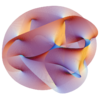P-form electrodynamics
Topic: Physics
 From HandWiki - Reading time: 3 min
From HandWiki - Reading time: 3 min
In theoretical physics, p-form electrodynamics is a generalization of Maxwell's theory of electromagnetism.
Ordinary (via. one-form) Abelian electrodynamics
We have a one-form [math]\displaystyle{ \mathbf{A} }[/math], a gauge symmetry
- [math]\displaystyle{ \mathbf{A} \rightarrow \mathbf{A} + d\alpha , }[/math]
where [math]\displaystyle{ \alpha }[/math] is any arbitrary fixed 0-form and [math]\displaystyle{ d }[/math] is the exterior derivative, and a gauge-invariant vector current [math]\displaystyle{ \mathbf{J} }[/math] with density 1 satisfying the continuity equation
- [math]\displaystyle{ d{\star}\mathbf{J} = 0 , }[/math]
where [math]\displaystyle{ {\star} }[/math] is the Hodge star operator.
Alternatively, we may express [math]\displaystyle{ \mathbf{J} }[/math] as a closed (n − 1)-form, but we do not consider that case here.
[math]\displaystyle{ \mathbf{F} }[/math] is a gauge-invariant 2-form defined as the exterior derivative [math]\displaystyle{ \mathbf{F} = d\mathbf{A} }[/math].
[math]\displaystyle{ \mathbf{F} }[/math] satisfies the equation of motion
- [math]\displaystyle{ d{\star}\mathbf{F} = {\star}\mathbf{J} }[/math]
(this equation obviously implies the continuity equation).
This can be derived from the action
- [math]\displaystyle{ S=\int_M \left[\frac{1}{2}\mathbf{F} \wedge {\star}\mathbf{F} - \mathbf{A} \wedge {\star}\mathbf{J}\right] , }[/math]
where [math]\displaystyle{ M }[/math] is the spacetime manifold.
p-form Abelian electrodynamics
We have a p-form [math]\displaystyle{ \mathbf{B} }[/math], a gauge symmetry
- [math]\displaystyle{ \mathbf{B} \rightarrow \mathbf{B} + d\mathbf{\alpha}, }[/math]
where [math]\displaystyle{ \alpha }[/math] is any arbitrary fixed (p − 1)-form and [math]\displaystyle{ d }[/math] is the exterior derivative, and a gauge-invariant p-vector [math]\displaystyle{ \mathbf{J} }[/math] with density 1 satisfying the continuity equation
- [math]\displaystyle{ d{\star}\mathbf{J} = 0 , }[/math]
where [math]\displaystyle{ {\star} }[/math] is the Hodge star operator.
Alternatively, we may express [math]\displaystyle{ \mathbf{J} }[/math] as a closed (n − p)-form.
[math]\displaystyle{ \mathbf{C} }[/math] is a gauge-invariant (p + 1)-form defined as the exterior derivative [math]\displaystyle{ \mathbf{C} = d\mathbf{B} }[/math].
[math]\displaystyle{ \mathbf{B} }[/math] satisfies the equation of motion
- [math]\displaystyle{ d{\star}\mathbf{C} = {\star}\mathbf{J} }[/math]
(this equation obviously implies the continuity equation).
This can be derived from the action
- [math]\displaystyle{ S=\int_M \left[\frac{1}{2}\mathbf{C} \wedge {\star}\mathbf{C} +(-1)^p \mathbf{B} \wedge {\star}\mathbf{J}\right] }[/math]
where M is the spacetime manifold.
Other sign conventions do exist.
The Kalb–Ramond field is an example with p = 2 in string theory; the Ramond–Ramond fields whose charged sources are D-branes are examples for all values of p. In 11-dimensional supergravity or M-theory, we have a 3-form electrodynamics.
Non-abelian generalization
Just as we have non-abelian generalizations of electrodynamics, leading to Yang–Mills theories, we also have nonabelian generalizations of p-form electrodynamics. They typically require the use of gerbes.
References
- Henneaux; Teitelboim (1986), "p-Form electrodynamics", Foundations of Physics 16 (7): 593-617, doi:10.1007/BF01889624
- Bunster, C.; Henneaux, M. (2011). "Action for twisted self-duality". Physical Review D 83 (12): 125015. doi:10.1103/PhysRevD.83.125015. Bibcode: 2011PhRvD..83l5015B.
- Navarro; Sancho (2012), "Energy and electromagnetism of a differential k-form ", J. Math. Phys. 53, 102501 (2012) doi:10.1063/1.4754817
 |
 KSF
KSF
